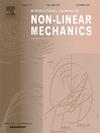冲击瞬态振动的孤子激励混合主动振动控制方法:数值视角
IF 2.8
3区 工程技术
Q2 MECHANICS
International Journal of Non-Linear Mechanics
Pub Date : 2025-06-26
DOI:10.1016/j.ijnonlinmec.2025.105198
引用次数: 0
摘要
设计了一种新的混合控制方法,其主要目标是尽可能快速有效地减小振动幅度,特别是在响应机械冲击时。本研究采用的控制方法是基于孤子启发波和传统的比例积分导数(PID)控制技术的集成的混合方法。针对二自由度、四自由度和五自由度振动系统,将所提出的混合控制方法与传统PID控制方法进行了比较。建立了振动系统的数学模型,并进行了数值模拟。在这些仿真中,发现所提出的控制技术比传统的PID进一步减轻了振动。此外,为了研究本研究中混合控制方法在实际工程系统中的适用性,考虑了半车模型和螺栓悬臂梁。对这两种不同的工程系统进行了数值模拟研究。通过对这些系统的数值仿真研究表明,所提出的混合控制方法比传统PID方法具有更好的主动振动控制性能。本文章由计算机程序翻译,如有差异,请以英文原文为准。
Soliton inspired hybrid active vibration control method for shock-induced transient vibrations: Numerical perspective
A novel hybrid control approach has been designed with the primary objective of minimizing vibration amplitude as quickly and effectively as possible, particularly in response to mechanical shocks. The control approach taken in this study is a hybrid methodology based on the integration of the soliton-inspired wave and the conventional Proportional-Integral-Derivative (PID) control technique. The proposed hybrid control approach is compared with the conventional PID control technique considering two-DOF, four-DOF and five-DOF vibratory systems. Mathematical models of these vibratory systems are established and simulated numerically. In these simulations, it was found that the presented control technique further mitigates vibrations than conventional PID. Moreover, to investigate the applicability of the hybrid control methodology in this research to real engineering systems, a half-vehicle model and bolted cantilever beams are considered. Numerical simulation studies are carried out for these two different engineering systems. Through numerical simulation studies conducted on these systems, it was revealed that the proposed hybrid control approach exhibits superior active vibration control performance to the conventional PID method.
求助全文
通过发布文献求助,成功后即可免费获取论文全文。
去求助
来源期刊
CiteScore
5.50
自引率
9.40%
发文量
192
审稿时长
67 days
期刊介绍:
The International Journal of Non-Linear Mechanics provides a specific medium for dissemination of high-quality research results in the various areas of theoretical, applied, and experimental mechanics of solids, fluids, structures, and systems where the phenomena are inherently non-linear.
The journal brings together original results in non-linear problems in elasticity, plasticity, dynamics, vibrations, wave-propagation, rheology, fluid-structure interaction systems, stability, biomechanics, micro- and nano-structures, materials, metamaterials, and in other diverse areas.
Papers may be analytical, computational or experimental in nature. Treatments of non-linear differential equations wherein solutions and properties of solutions are emphasized but physical aspects are not adequately relevant, will not be considered for possible publication. Both deterministic and stochastic approaches are fostered. Contributions pertaining to both established and emerging fields are encouraged.

 求助内容:
求助内容: 应助结果提醒方式:
应助结果提醒方式:


